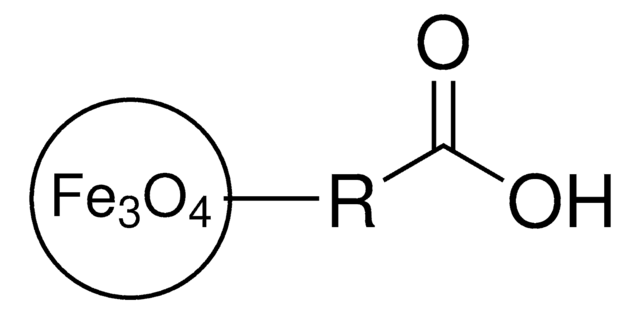725358
Iron oxide(II,III), magnetic nanoparticles solution
10 nm avg. part. size, 5 mg/mL in H2O
Synonyme(s) :
Magnetic iron oxide nanocrystals, Magnetite, Superparamagnetic iron oxide nanoparticles
About This Item
Forme
dispersion
nanoparticles
Niveau de qualité
Concentration
5 mg/mL in H2O
Magnétisation
>45 emu/g, at 4500Oe
Taille moy. des particules
10 nm
Taille des particules
9-11 nm (TEM)
Densité
1.00 g/mL at 25 °C
Chaîne SMILES
O=[Fe].O=[Fe]O[Fe]=O
InChI
1S/3Fe.4O
Clé InChI
SZVJSHCCFOBDDC-UHFFFAOYSA-N
Vous recherchez des produits similaires ? Visite Guide de comparaison des produits
Catégories apparentées
Description générale
Application
- Optical resolution of ephedrine: A study explored the optical resolution of racemic ephedrine using various derivatives of tartaric acid, presenting a method that could refine the production of pharmaceutical-grade ephedrine hydrochloride (Bánhegyi et al., 2022).
- Stereoselective forensic analysis: Supercritical fluid chromatography coupled with tandem mass spectrometry was used to perform a stereoselective analysis of ephedrine and its isomers in seized methamphetamine samples, offering insights into forensic applications of ephedrine hydrochloride (Segawa et al., 2021).
- Chiral analysis of stimulants: A chiral high-performance liquid chromatography-tandem mass spectrometry method was applied to determine amphetamine-type stimulants, including ephedrine, in forensic samples, providing a tool for the precise separation and identification of chiral drugs (Schwelm et al., 2020).
Code de la classe de stockage
12 - Non Combustible Liquids
Classe de danger pour l'eau (WGK)
nwg
Point d'éclair (°F)
Not applicable
Point d'éclair (°C)
Not applicable
Certificats d'analyse (COA)
Recherchez un Certificats d'analyse (COA) en saisissant le numéro de lot du produit. Les numéros de lot figurent sur l'étiquette du produit après les mots "Lot" ou "Batch".
Déjà en possession de ce produit ?
Retrouvez la documentation relative aux produits que vous avez récemment achetés dans la Bibliothèque de documents.
Les clients ont également consulté
Articles
Currently, magnetic nanoparticles (MNPs) are attracting a lot of attention because of the possibility of many novel applications, especially in biomedical research.
A key challenge for nanomaterial safety assessment is the ability to handle the large number of newly engineered nanomaterials (ENMs), including developing cost-effective methods that can be used for hazard screening.
Professor Hui Mao explores the use of superparamagnetic iron oxide nanoparticles (INOPs) that offer an alternate contrast-enhancing mechanism.
Professor Yadong Yin (University of California Riverside, USA) examines both direct (thermal decomposition, solvothermal, hydrothermal) and indirect (templated) synthesis methods of magnetite nanocrystals and reviews in detail the landscape of these various synthetic methods for magnetite nanocrystal and their applications in magnetic assembly, magnetic hyperthermia, and Li-Ion batteries.
Notre équipe de scientifiques dispose d'une expérience dans tous les secteurs de la recherche, notamment en sciences de la vie, science des matériaux, synthèse chimique, chromatographie, analyse et dans de nombreux autres domaines..
Contacter notre Service technique

